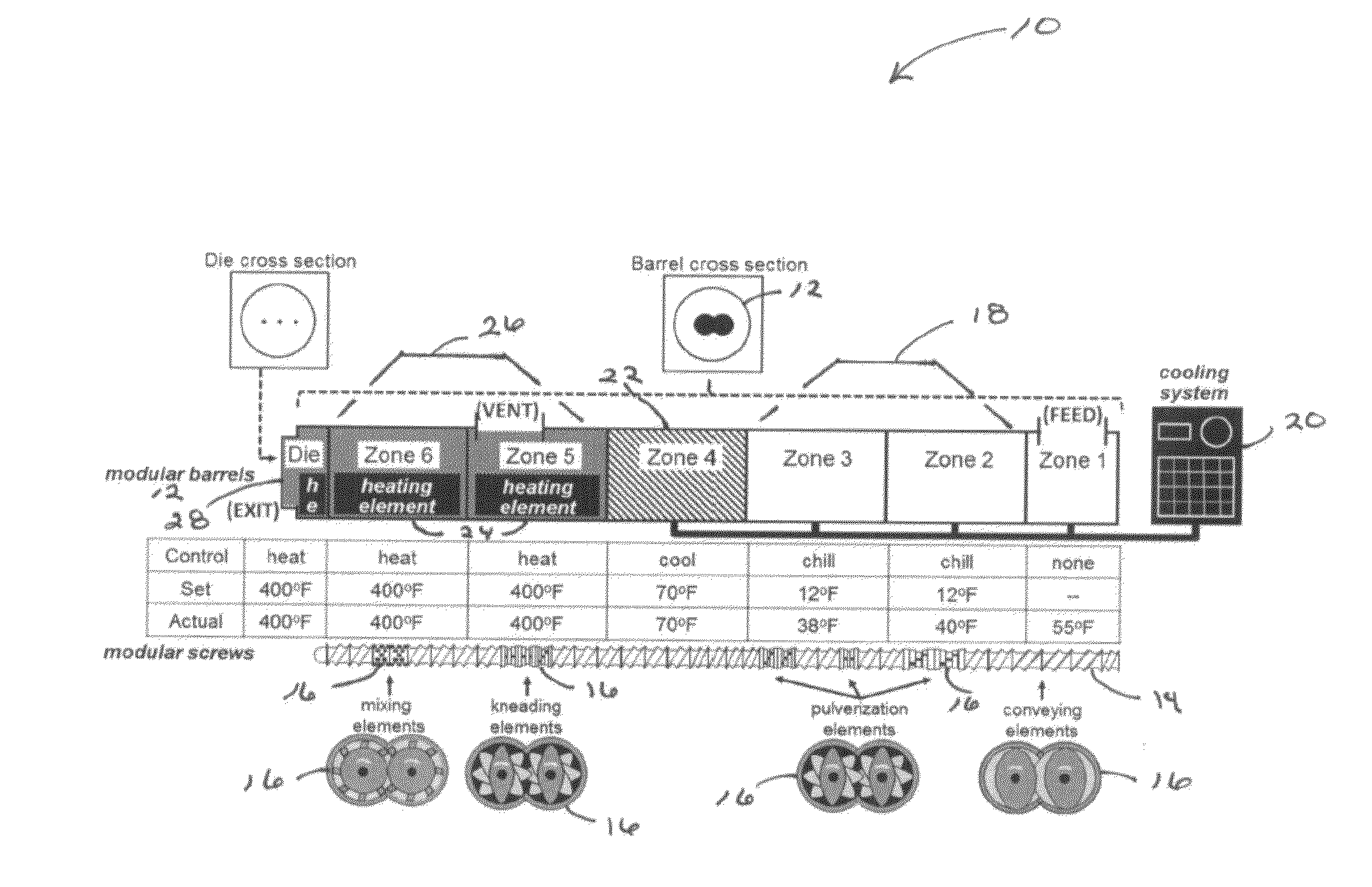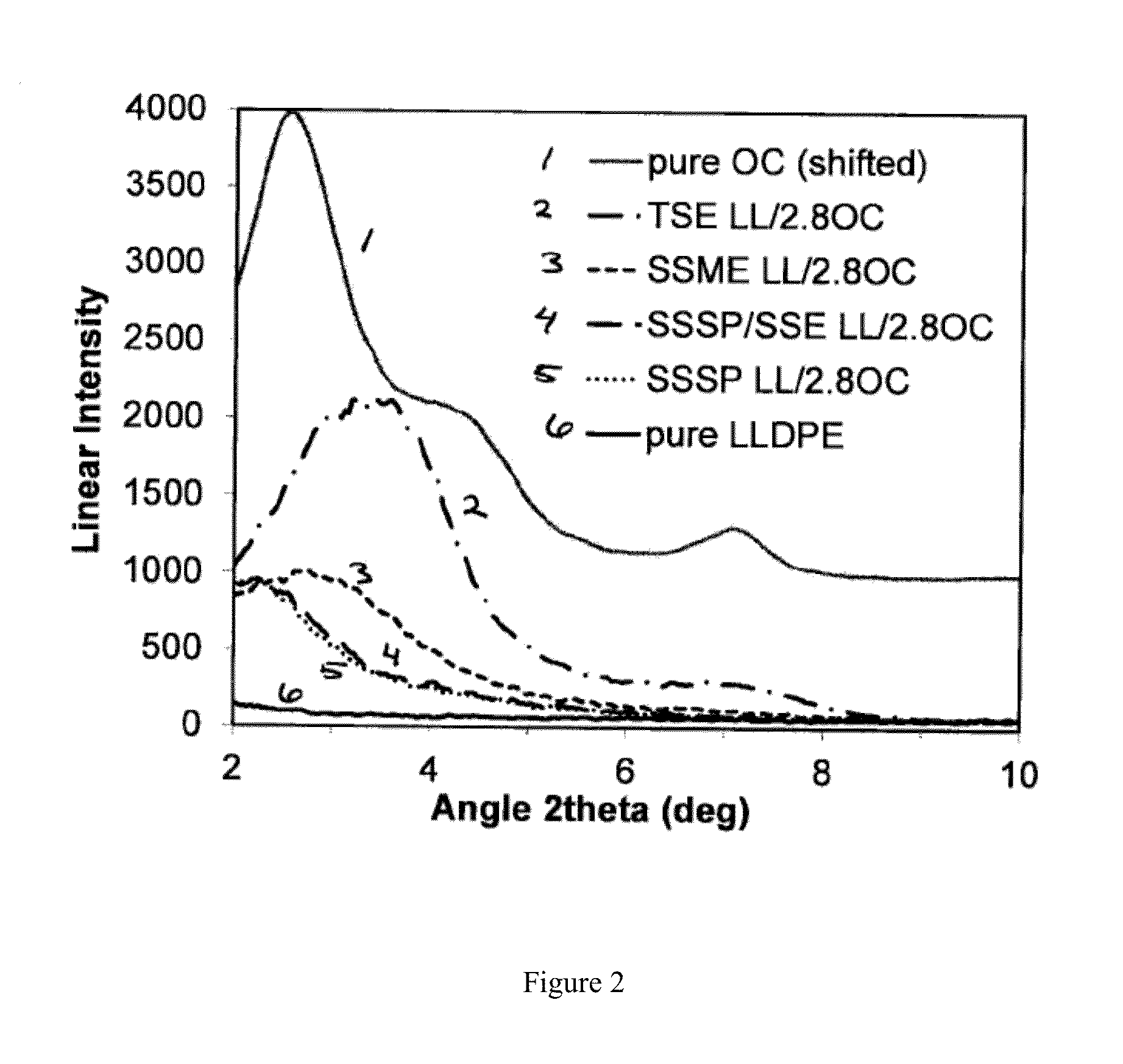Process for Producing Exfoliated and/or Dispersed Polymer Composites and/or Nanocomposites via Solid-State/Melt Extrusion (SSME)
a polymer composite and nanocomposites technology, applied in the field of extrusion of can solve the problems of insufficient heat dissipation in tse, ineffective tse for producing high-performance polymer composites and/or nanocomposites, thermal degradation of materials, etc., and achieves the effects of effective exfoliation and/or dispersibility, enhanced mechanical properties, and easy post-processing
- Summary
- Abstract
- Description
- Claims
- Application Information
AI Technical Summary
Benefits of technology
Problems solved by technology
Method used
Image
Examples
example 1
[0031]Polymer nanocomposites samples were prepared from linear-low density polyethylene, or LLDPE (Dowlex 2027G, Dow Chemical Company), and organically modified montmorillonite clay, or OC (Cloisite 15A, Southern Clay Products), using the four contrastive techniques outlined in Table 1, viz., (1) conventional TSE, (2) conventional SSSP, (3) SSSP followed by single-screw extrusion (SSE), and (4) the new SSME. The nanocomposite samples were fabricated using a Krauss-Maffei Berstorff ZE25-UTX extruder. The nominal filler content was targeted to be 4 wt% in all cases. The actual filler contents in each sample were measured by ash content testing, in accordance with ASTM D5630.
TABLE 1Process Variables for the LLDPE / O-C Nanocomposite Fabrication MethodsTarget FillerActual Filler Content ContentThroughputMethod(wt %)(wt %)(g / hr)Output FormTSE4.02.8 ± 0.13200Molten strandsSSSP4.02.8 ± 0.2200PowderSSSP / SSE4.02.8 ± 0.2200Powder, then molten strandsSSME4.02.8 ± 0.12500Molten strands
[0032]Proce...
example 2
[0033]Nanocomposite Morphology: X-Ray diffraction (XRD; 40 kV, 45 mA, CuKa) was employed to investigate the filler morphology of the nanocomposite samples. The results are plotted in FIG. 2. Based on the governing Bragg's Law, the peak(s) within the 20 range of 2-10° signify the presence of agglomerated, non-exfoliated clay particles, with a lower the peak height on the XRD curve corresponding to a greater degree of exfoliation (and dispersion) of the filler. The results in FIG. 2 show that the nanocomposite sample prepared by TSE exhibits a relatively large characteristic clay peak, indicating that TSE is not effective for exfoliating and / or dispersing the clay particles. In contrast, the nanocomposite samples prepared by SSSP and SSSP / SSE exhibit reduced peak heights. Thus, SSSP processing is more effective at exfoliating and / or dispersing the clay fillers in the polymer. The nanocomposite sample prepared by the SSME process also shows a reduced characteristic clay peak height, in...
example 3
[0034]Physical Properties: Uniaxial tensile testing on the compression-molded specimens of the LLDPE-OC nanocomposites was conducted based on ASTM D1708. Average Young's modulus values, which represent the stiffness of the samples, are presented in FIG. 3 (The error bars represent one standard deviations.). Processing LLDPE with clay, leading to products with 2.8 wt.% OC content, by SSME yields significant enhancement in stiffness (i.e., higher Young's modulus) relative to pure LLDPE and LLDPE-OC nanocomposites made by TSE.
[0035]The SSME methods of this invention can effectively produce polymer composites and / or nanocomposites that have well-exfoliated and / or well-dispersed filler morphologies. As a result, the mechanical properties of the composites and / or nanocomposites are superior to those prepared by conventional TSE processing techniques and comparable to SSSP alone. Moreover, the SSME process yields forms of output, e.g., strands, pellets, or films, that increases ease of han...
PUM
| Property | Measurement | Unit |
|---|---|---|
| wt. % | aaaaa | aaaaa |
| wt. % | aaaaa | aaaaa |
| length | aaaaa | aaaaa |
Abstract
Description
Claims
Application Information
 Login to View More
Login to View More - R&D
- Intellectual Property
- Life Sciences
- Materials
- Tech Scout
- Unparalleled Data Quality
- Higher Quality Content
- 60% Fewer Hallucinations
Browse by: Latest US Patents, China's latest patents, Technical Efficacy Thesaurus, Application Domain, Technology Topic, Popular Technical Reports.
© 2025 PatSnap. All rights reserved.Legal|Privacy policy|Modern Slavery Act Transparency Statement|Sitemap|About US| Contact US: help@patsnap.com



